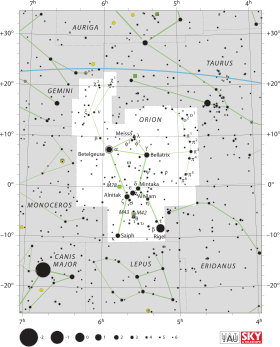|
Phi1 Orionis (φ1 Ori / φ1 Orionis) est une étoile binaire de la constellation d'Orion, située à environ ∼ 1 090 a.l. (∼ 334 pc) de la Terre[1]. Elle se situe à moins d'un degré au sud de Meissa[9]. Elle est visible à l’œil nu avec une magnitude visuelle apparente de 4,42[2].
Phi1 Orionis est une étoile binaire spectroscopique à une raies simples avec une période orbitale de 3 068 jours et une excentricité de 0,22[10]. Elle fait partie du jeune amas de Lambda Orionis[11], qui est âgé d'environ sept millions d'années[7]. La composante primaire est une étoile géante bleue de type spectral B0 III[3]. Elle est environ 15 fois plus massive que le Soleil et fait environ 6,3 fois son rayon[5]. Son compagnon, la composante secondaire du système, est inconnue. Elle ne contribue pas de manière significative à la luminosité du spectre visible[5].
Notes et références
- ↑ a b c d e et f (en) F. van Leeuwen, « Validation of the new Hipparcos reduction », Astronomy & Astrophysics, vol. 474, no 2, , p. 653–664 (DOI 10.1051/0004-6361:20078357, Bibcode 2007A&A...474..653V, arXiv 0708.1752)
- ↑ a b c et d (en) P. Murdin et M. V. Penston, « The Lambda Orionis association », Monthly Notices of the Royal Astronomical Society, vol. 181, , p. 657–665 (DOI 10.1093/mnras/181.4.657, Bibcode 1977MNRAS.181..657M)
- ↑ a et b (en) H. Levato, « Rotational velocities and spectral types for a sample of binary systems », Astronomy & Astrophysics Supplement Series, vol. 19, , p. 91–99 (Bibcode 1975A&AS...19...91L)
- ↑ (en) Ralph Elmer Wilson, General catalogue of stellar radial velocities, Carnegie Institution of Washington, (Bibcode 1953GCRV..C......0W)
- ↑ a b c d e f et g (en) María-Fernanda Nieva et Norbert Przybilla, « Fundamental properties of nearby single early B-type stars », Astronomy & Astrophysics, vol. 566, , A7 (DOI 10.1051/0004-6361/201423373, Bibcode 2014A&A...566A...7N, arXiv 1412.1418)
- ↑ (en) S. Simón-Díaz et A. Herrero, « The IACOB project. I. Rotational velocities in northern Galactic O- and early B-type stars revisited. The impact of other sources of line-broadening », Astronomy & Astrophysics, vol. 562, , A135 (DOI 10.1051/0004-6361/201322758, Bibcode 2014A&A...562A.135S, arXiv 1311.3360)
- ↑ a et b (en) N. Tetzlaff, R. Neuhäuser et M. M. Hohle, « A catalogue of young runaway Hipparcos stars within 3 kpc from the Sun », Monthly Notices of the Royal Astronomical Society, vol. 410, , p. 190 (DOI 10.1111/j.1365-2966.2010.17434.x, Bibcode 2011MNRAS.410..190T, arXiv 1007.4883)
- ↑ (en) * phi01 Ori -- Spectroscopic binary sur la base de données Simbad du Centre de données astronomiques de Strasbourg.
- ↑ (en) Stephen James O'Meara, Deep-Sky Companions : Hidden Treasures, Cambridge University Press, , 584 p. (ISBN 978-1-139-46373-7 et 1-139-46373-X, lire en ligne), p. 146
- ↑ (en) D. Pourbaix et al., « SB9: The ninth catalogue of spectroscopic binary orbits », Astronomy & Astrophysics, vol. 424, , p. 727-732 (DOI 10.1051/0004-6361:20041213, Bibcode 2004A&A...424..727P, arXiv astro-ph/0406573)
- ↑ (en) Jesús Hernández et al., « Spitzer Observations of the λ Orionis Cluster. I. The Frequency of Young Debris Disks at 5 Myr », The Astrophysical Journal, vol. 707, no 1, , p. 705–715 (DOI 10.1088/0004-637X/707/1/705, Bibcode 2009ApJ...707..705H, arXiv 0910.3884)
Lien externe
|

